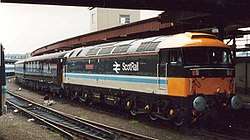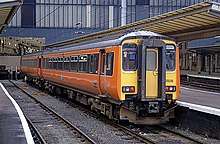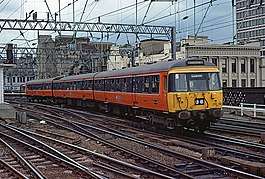ScotRail (British Rail)
The ScotRail trading name was adopted on 22 September 1983, under manager Chris Green, British Railways Scottish Region to provide a distinctive brand for the British Rail network in Scotland.[1]
 | |
| Franchise(s) | 22 September 1983 – 30 March 1997 |
|---|---|
| Main Region(s) | Scotland |
| Parent company | British Rail |
Services
ScotRail was responsible for all passenger services that operated wholly within Scotland. It also operated services across the English border to Carlisle, and from 5 March 1988, took over operation of the Caledonian Sleeper services to London Euston.[2] Services from south of the border via the East Coast and West Coast Main Lines remained the responsibility of InterCity.
Infrastructure
The Ayrshire Coast Line was electrified in September 1986, as was the North Berwick Line in July 1991.
Rolling stock
During its tenure, much of Scotland's locomotive hauled passenger carriage fleet was replaced by Class 150, Class 156 and Class 158 diesel multiple units. It also introduced cascaded Class 305s as well as new Class 318 and Class 320 electric multiple units.
| Class | Image | Type | Top speed | Number | Cars | Built | |
|---|---|---|---|---|---|---|---|
| mph | km/h | ||||||
| Locomotive hauled stock | |||||||
| 37 | .jpg) |
Diesel locomotive | 90 | 145 | N/A | 1960–65 | |
| 47 |  |
75 | 121 | At least 12 | 1962–68 | ||
| 86 |  |
Electric locomotive | 100–110 | 161–177 | 1965–66 | ||
| 87 | .jpg) |
110 | 177 | 1973–75 | |||
| Mark 1 | Passenger carriage | 90–100 | 145–161 | – | 1951–63 | ||
| Mark 2 | 100 | 161 | 1963–75 | ||||
| Mark 3 | 125 | 200 | 1975–88 | ||||
| DBSO | 100 | 161 | At least 12 | 1979 | |||
| Diesel multiple units | |||||||
| 101 | Diesel multiple unit | 70 | 113 | At least 12 | 2, 3 or 4 | 1956–60 | |
| 104 | A few | 1957–59 | |||||
| 107 | 26 | 3 | 1960 | ||||
| 116 | 14 | 2 or 3 | 1957–61 | ||||
| 150 Sprinter |  |
75 | 121 | 18 | 2 | 1986–87 | |
| 156 Super Sprinter |  |
14 | 1987–89 | ||||
| 158 Express Sprinter |  |
90 | 145 | 46 | 1989–92 | ||
| Electric multiple units | |||||||
| 303 | Electric multiple unit | 75 | 121 | 91 | 3 | 1959–61 | |
| 305 | 19 | 3 or 4 | 1959 | ||||
| 311 |  |
19 | 3 | 1967 | |||
| 314 |  |
70 | 113 | 16 | 1979 | ||
| 318 | 90 | 145 | 21 | 1985–86 | |||
| 320 |  |
75 | 121 | 22 | 1990 | ||
Liveries
When formed in 1983, customised versions of the existing British Rail liveries were adopted, with passenger locomotives and coaching stock painted in a lightly modified version of the InterCity Executive livery. The red stripe was replaced with a saltire blue stripe, and the InterCity name was replaced with the ScotRail name. Most locomotives carried the standard InterCity Executive livery but with ScotRail branding. Diesel and Electric multiple units carried normal versions of the Regional Railways livery. In the SPT area, rolling stock was painted in Strathclyde Orange and Black.
References
- Stewart, Valerie & Chadwick, Vivian (1987). Changing Trains: messages for management from the ScotRail challenge. Newton Abbot: David & Charles. ISBN 0-7153-8870-3.
- "Inverness depot to remain open" The Railway Magazine issue 1128 April 1995 page 31
Further reading
- Perren, Brian; Noble, Tom; Brown, Murray (June 1988). "Focus on ScotRail". RAIL. No. 81. EMAP National Publications. Supplement. ISSN 0953-4563. OCLC 49953699.
| Preceded by Regional Railways |
Operator of Scotland passenger services 1983-97 |
Succeeded by ScotRail (National Express) |